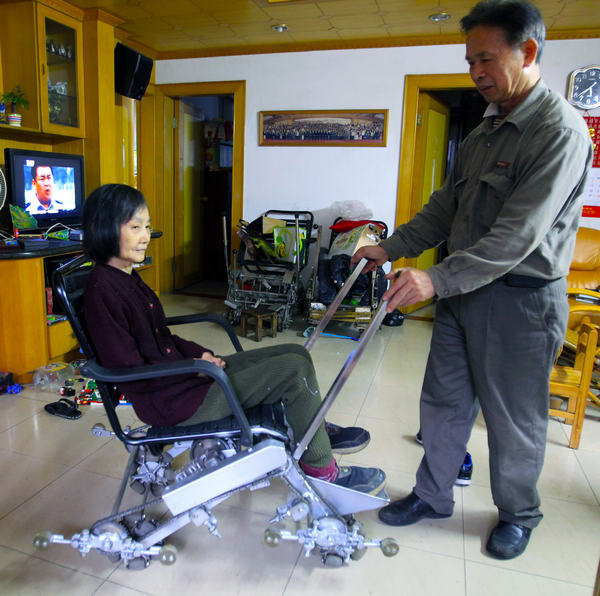Maybe it was just natural to expect that inventor Liu Tie'er would turn his attention toward helping his wife deal with rheumatoid arthritis.
With joints deformed by the disease, even a single step is painful for Su Huiqiong.
Forget about negotiating the 23 steps from their apartment to the ground floor in an old neighborhood of Guangzhou.
That is until Liu put his mind to finding a solution, and developed a wheelchair that can go up and down stairs.
Built with four wheels instead of two, the wheelchair is driven by bicycle chains and controlled by two levers, allowing Su to go up and down the steps to their home in two minutes.
"This is the eighth version of the special wheelchair I've made and the most satisfying one by far," said Liu, 70, who claims to be a perfectionist.
He started working on the wheelchair in 2009 when his wife's illness became more serious.
"I have been improving the design and upgrading the wheelchair over the past three years."
The chair attracts a lot of attention.
"Curious visitors in the parks crowd around my husband and ask him to show how the wheelchair climbs stairs while I sit nearby and wait impatiently," Su complained, but with an element of pride in her voice.
"They even visit our apartment to try out the wheelchair or ask my husband to travel to their homes to design a wheelchair for the stairs in their buildings."
After China Central Television reported his invention on its show I Love Inventions on March 27, Liu has been busy taking phone calls from all over the country.
The steady flow of orders has assured Liu of his invention's market potential but at the same time confronted him with one difficult task after another - he soon discovered that the first wheelchair needed many improvements to satisfy customers' various requirements.
"However, I didn't mind taking the trouble to upgrade the wheelchair again and again," Liu said. "The more people it helps, the more valuable my efforts are and the happier I am."
To enable the wheelchair to easily make turns in narrow spaces in old buildings, Liu transformed the four big wheels into four sets of small wheels, 10 for each set.
Liu is planning to put the wheelchair into mass production and price each unit according to how well it is equipped.
The simplest manual wheelchair will cost less than 3,000 yuan ($475). The most advanced version will cost between 6,000 and 7,000 yuan.
Imported wheelchairs with similar functions are priced several times higher.
"My husband has been immersed in innovations," said Su, who recalled that Liu wouldn't be home until 11 pm when he was working as a truck driver at an electrical appliance factory in the city. He was not on business trips but burying himself in piles of machinery parts and blueprints.
"But this is a good hobby because his inventions can help people," Su smiled.

Liu became famous across the country long ago as an expert in technological innovation. He received the honor of being declared a national worker model in 1995 and was listed as one of the country's top 10 workers in 1998.
Back in 1968, Liu designed a forklift. Three years later, he assembled an engine, gearbox and other components to make a heavy truck.
At the time, machines and vehicles were scarce in China and the country relied a lot on supplies from the former Soviet Union.
"The forklift and the truck significantly increased productivity and became my factory's treasures at that time," said Liu, displaying a jaunty smile. "The crude, self-made truck actually functioned well and was in use for six years."
The inventor ended his formal education after primary school to work on a farm. However, the studious boy would finish his tasks as quickly as possible and then run barefoot more than three kilometers from the village to a library in the county.
"I enjoy learning, thinking and taking challenges," said Liu, who still goes to the library at least once every week. "I would be uncomfortable if I stayed idle."
(Source: China Daily)
|
Copyright © 2003-2018 China Intellectual Property Magazine,All rights Reserved . www.chinaipmagazine.com 京ICP备09051062号 |
|
|


